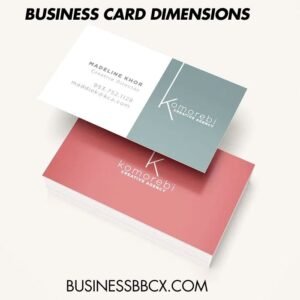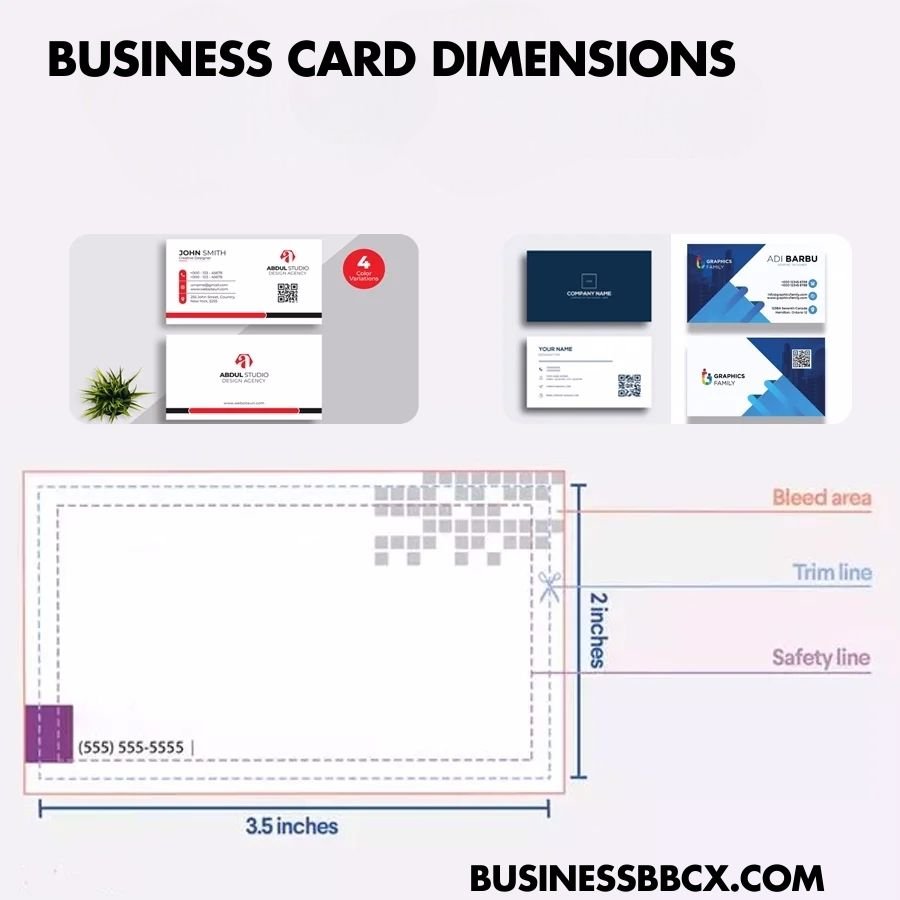In the world of professional networking, your business card is more than just a piece of paper—it’s your first impression, your brand, and often your ticket to making lasting connections. The dimensions of your business card play a crucial role in its usability and impact. Let’s dive into the details and help you choose the perfect size for your next set of business cards.
Table of Contents
ToggleWhat is Business Card Dimensions

Business Card Dimensions refer to the standard or custom sizes used for creating business cards. These dimensions determine the physical size of the card and play a significant role in how it looks, feels, and fits into cardholders or wallets.
Standard Business Card Dimensions

Global Standards
Business card sizes can vary slightly depending on the region. Here are the most common dimensions:
- United States and Canada: 3.5 inches × 2 inches (88.9 mm × 50.8 mm)
- Europe: 3.35 inches × 2.17 inches (85 mm × 55 mm)
- Japan: 3.58 inches × 2.17 inches (91 mm × 55 mm)
These dimensions are designed to fit comfortably in wallets, cardholders, and pockets, making them highly practical and universally accepted.
Why Size Matters
Portability
A card that’s too large might not fit in a wallet or business card holder, leading to inconvenience for the recipient. Conversely, a card that’s too small might get lost easily or feel insubstantial.
Design Space
The dimensions of your card dictate the space available for your design elements—your logo, contact details, and perhaps a tagline or QR code. Choosing the right size ensures your card isn’t overcrowded or awkwardly sparse.
Branding and Uniqueness
While standard dimensions are common, choosing an unconventional size or shape can make your card stand out. However, be cautious—practicality should not be sacrificed for creativity.
Custom Dimensions and Creative Variations
While sticking to standard sizes is practical, custom dimensions can create a memorable impression. Here are a few options to consider:
- Square Cards: 2.5 inches × 2.5 inches—great for modern, minimalist designs.
- Mini Cards: 3 inches × 1 inch—compact and sleek, ideal for subtle branding.
- Folded Cards: 3.5 inches × 4 inches (folded to 3.5 inches × 2 inches)—provides extra space for information.
Tip: Always ensure that your custom-sized cards are compatible with standard storage options like wallets or business card holders.
Bleed and Safety Margins
When designing a business card, it’s essential to account for:
- Bleed Area: Extending design elements slightly beyond the final trim size (usually 0.125 inches or 3 mm on each side) ensures that there are no white edges after cutting.
- Safety Margins: Keeping text and essential elements at least 0.125 inches or 3 mm inside the trim line prevents them from being accidentally cut off.
Material and Thickness Considerations
Card dimensions might also feel different based on the card’s material and thickness. A thicker card with a standard size may feel more premium, while thinner cards with unconventional sizes may appear less professional. Choose a card stock that complements your design and brand identity.
Tips for Choosing the Right Dimensions

Know Your Audience: Are you targeting professionals in a corporate environment? Stick to standard sizes. Creative industries? Feel free to explore unique dimensions.
Think Practically: A visually stunning card is great, but it must also be functional.
Test Before Printing: Print a few samples of your design at the chosen size to ensure readability and overall appeal.
Why Dimensions Matter
- Portability: Cards that fit wallets or holders are more likely to be kept.
- Design Space: Dimensions affect the layout of your text, logo, and other branding elements.
- Professionalism: A card that is too large or too small may seem unconventional or impractical unless done with a purpose.
Final Thoughts
The dimensions of your business card might seem like a minor detail, but they significantly impact how your brand is perceived. Whether you choose standard sizes for practicality or custom sizes to stand out, ensure your design is cohesive, professional, and aligned with your brand identity.
Remember, your business card is often the first tangible impression of your brand—make it count!
FAQs About Business Card Dimensions
What are the standard business card dimensions?
The standard business card dimensions in the United States are 3.5 inches × 2 inches, while in Europe, the dimensions are slightly different at 3.35 inches × 2.17 inches.
Do business card dimensions vary by country?
Yes, business card dimensions can vary by region, with Japan favoring dimensions of 3.58 inches × 2.17 inches, which are slightly larger than the European standard.
Can I use custom business card dimensions for my design?
Absolutely, you can choose custom business card dimensions, such as square or mini cards, but ensure they remain practical and easy to carry.
What is the importance of bleed and trim in business card dimensions?
Bleed and trim are critical for business card dimensions as they ensure your design extends beyond the edge for a polished finish after cutting.
How do business card dimensions impact design elements?
Business card dimensions directly influence the layout, determining the space available for text, logos, and any additional branding.
Are there eco-friendly options for standard business card dimensions?
Yes, eco-friendly materials can be used without altering standard business card dimensions, ensuring both sustainability and professionalism.


